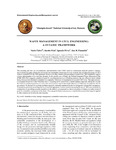Mostrar o rexistro simple do ítem
Waste management in civil engineering: a dynamic framework
| dc.contributor.author | Calvo, Nuria | |
| dc.contributor.author | Feás, Jacobo | |
| dc.contributor.author | Pérez Pérez, Ignacio | |
| dc.contributor.author | Pasandín, A.R. | |
| dc.date.accessioned | 2021-01-27T15:39:16Z | |
| dc.date.available | 2021-01-27T15:39:16Z | |
| dc.date.issued | 2015 | |
| dc.identifier.citation | Calvo, N., Feás, J., Pérez, I., & Pasandín, A. R. (2015). WASTE MANAGEMENT IN CIVIL ENGINEERING: A DYNAMIC FRAMEWORK. Environmental Engineering & Management Journal (EEMJ), 14(8). DOI: 10.30638/eemj.2015.208 | es_ES |
| dc.identifier.uri | http://hdl.handle.net/2183/27239 | |
| dc.description.abstract | [Abstract:] The recycling and later use of construction and demolition waste (C&D waste) as construction materials present a strategic inconvenience for many stakeholders involved in the sustainable construction. In some countries, the recycling percentage of C&D waste is around 80% of the C&D generated. However, in other countries this percentage is much lower. This complexity requires a better understanding of the recycling dynamic. In the specific case of Spain, the National Integrated Waste Management Plan (PNIR 2008-2015) suggests a number of goals for recycling and recovery of building materials that are difficult to meet without laying down policies intended to stimulate the companies´ behaviour of consumption of recycled C&D waste. This paper presents a conceptual framework within which the issue of recycling can be raised from a multidisciplinary approach, taking into account the technical conditioning factors as well as the socioeconomic aspects that might influence the behaviour of companies and the government. On the basis of a systemic problem approach, a dynamic simulation model was designed to evaluate the consequences of incentives policies by promoting the use of recycled aggregates. Actions aimed at increasing the use of C&D waste materials in construction, by providing economic incentives to the industry, are proposed as a short-term policy to balance the achievement of goals for sustainable construction in the future. This conceptual framework possesses a transferable potential that might be applied to other countries involved in the same dynamic. | es_ES |
| dc.description.sponsorship | Ministerio de Educación y Ciencia; BIA 2010-17751 | es_ES |
| dc.description.sponsorship | Consellería de Innovación; 10MDS012CT | es_ES |
| dc.language.iso | eng | es_ES |
| dc.publisher | “Gheorghe Asachi” Technical University of Iasi | es_ES |
| dc.relation.uri | https://doi.org/10.30638/eemj.2015.208 | es_ES |
| dc.rights | Todos os dereitos reservados pola revista Environmental Engineering & Management Journal (EEMJ). | es_ES |
| dc.rights | Environmental Engineering & Management Journal (EEMJ): All rights reserved, including those of translation into foreign languages. No part of each issue may be reproduced in any form (photoprint, microfilm, or any other means) nor transmitted or translated without written permission from the publishers. Only single copies of contributions, or parts thereof may be made for personal use. The copyright and trademark belong to the Editor-in-Chief and EcoZone Publishing House under Academic Organization for Environmental Engineering and Sustainable Development (Organizaţia Academică pentru Ingineria Mediului şi Dezvoltare Durabilă, O.A.I.M.D.D.), respectively. | es_ES |
| dc.subject | Demolition waste | es_ES |
| dc.subject | Strategic management | es_ES |
| dc.subject | Sustainable construction | es_ES |
| dc.subject | System dynamics | es_ES |
| dc.title | Waste management in civil engineering: a dynamic framework | es_ES |
| dc.type | info:eu-repo/semantics/article | es_ES |
| dc.rights.access | info:eu-repo/semantics/openAccess | es_ES |
| UDC.journalTitle | Environmental Engineering & Management Journal (EEMJ) | es_ES |
| UDC.volume | 14 | es_ES |
| UDC.issue | 8 | es_ES |
| UDC.startPage | 1941 | es_ES |
| UDC.endPage | 1952 | es_ES |
| dc.identifier.doi | 10.30638/eemj.2015.208 |
Ficheiros no ítem
Este ítem aparece na(s) seguinte(s) colección(s)
-
CITEEC-CGM - Artigos [96]






